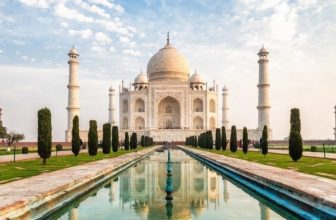Monday Flashback Story : Golconda Fort – A Sustainable Heritage Fort from Qutb Shahi Architecture
Golconda Fort, also known as Golla Konda, is a fortified citadel built by the Kakatiyas and an early capital city of the Qutb Shahi dynasty (c. 1512–1687), located in Hyderabad, Telangana, India. Because of the vicinity of diamond mines, especially the Kollur Mine, Golconda flourished as a trade center of large diamonds, known as the Golconda Diamonds. The region has produced some of the world’s most famous diamonds, including the colorless Koh-i-Noor (now owned by the United Kingdom), the blue Hope (United States), the pink Daria-i-Noor (Iran), the white Regent (France), the Dresden Green (Germany), and the colorless Orlov (Russia), Nizam and Jacob (India), as well as the now-lost diamonds Florentine Yellow, Akbar Shah, and Great Mogul.
The Qutb Shahi tombs are the necropolis of the Qutb Shahi rulers, set in a vast garden on the outskirts of the Golconda Fort. The tombs share a common features : an onion dome atop a cube surrounded by an arcade with rich ornamental details, with small minarets featuring floral motifs.
It was initially called Shepherd’s Hill, meaning Golla Konda in Telugu while according to legend, on this rocky hill a shepherd boy had come across an idol and the information was conveyed to the ruling Kakatiya king at that time. The king constructed a mud fort around this holy spot and after 200 years, Bahamani rulers took possession of the place. Under the Bahmani Sultanate, Golconda slowly rose to prominence. Sultan Quli Qutb-ul-Mulk (r. 1487–1543), sent by the Bahmanids as a governor at Golconda, established the city as the seat of his government around 1501. Bahmani rule gradually weakened during this period, and Sultan Quli formally became independent in 1538, establishing the Qutb Shahi dynasty based in Golconda. Over a period of 62 years, the mud fort was expanded by the first three Qutb Shahi sultans into the present structure, a massive fortification of granite extending around 5 km (3.1 mi) in circumference. It remained the capital of the Qutb Shahi dynasty until 1590 when the capital was shifted to Hyderabad. The Qutb Shahis expanded the fort, whose 7 km (4.3 mi) outer wall enclosed the city.


During the early seventeenth century a strong cotton-weaving industry existed in Golconda. Large quantities of cotton were produced for domestic and exports consumption. High-quality plain or patterned cloth made of muslin and calico was produced. The plain cloth was available as white or brown color, in bleached or dyed variety. Exports of this cloth were to Persia and European countries. The patterned cloth was made of prints which were made indigenously with indigo for blue, chay-root for red-colored prints and vegetable yellow. Patterned cloth exports were mainly to Java, Sumatra, and other eastern countries.
Golconda Fort is listed as an archaeological treasure on the official “List of Monuments” prepared by the Archaeological Survey of India under The Ancient Monuments and Archaeological Sites and Remains Act. Golconda consists of four distinct forts with a 10 km (6.2 mi) long outer wall with 87 semicircular bastions (some still mounted with cannons), eight gateways, and four drawbridges, with a number of royal apartments and halls, temples, mosques, magazines, stables, etc. inside. The lowest of these is the outermost enclosure entered by the “Fateh Darwaza” (Victory gate, so-called after Aurangzeb’s triumphant army marched in through this gate) studded with giant iron spikes (to prevent elephants from battering them down) near the south-eastern corner. An acoustic effect can be experienced at Fateh Darwazaan, a hand clap at a certain point below the dome at the entrance reverberates and can be heard clearly at the ‘Bala Hisar’ pavilion, the highest point almost a kilometer away. This worked as a warning in case of an attack.

Bala Hissar Gate is the main entrance to the fort located on the eastern side. It has a pointed arch bordered by rows of scrollwork. The spandrels have yalis and decorated roundels. The area above the door has peacocks with ornate tails flanking an ornamental arched niche. The granite block lintel below has sculpted yalis flanking a disc. The design of peacocks and lions is typical of Hindu architecture and underlies this fort’s Hindu origins.
Toli Masjid, situated at Karwan, about 2 km (1.2 mi) from the Golconda Fort, was built in 1671 by Mir Musa Khan Mahaldar, royal architect of Abdullah Qutb Shah. The facade consists of five arches, each with lotus medallions in the spandrels. The central arch is slightly wider and more ornate. The mosque inside is divided into two halls, a transverse outer hall and an inner hall entered through triple arches.
It is believed that there is a secret tunnel that leads from the “Durbar Hall” and ends in one of the palaces at the foot of the hill.[citation needed] The fort also contains the tombs of the Qutub Shahi kings. These tombs have Islamic architecture and are located about 1 km (0.62 mi) north of the outer wall of Golconda. They are encircled by beautiful gardens and numerous carved stones. It is also believed that there was a secret tunnel to Charminar.

The two individual pavilions on the outer side of Golconda are built on a point which is quite rocky. The “Kala Mandir” is also located in the fort. It can be seen from the king’s durbar (king’s court) which was on top of the Golconda Fort.
The other buildings found inside the fort are:
Habshi Kamans (Abyssian arches), Ashlah Khana, Taramati mosque, Ramadas Bandikhana, Camel stable, private chambers (kilwat), Mortuary bath, Nagina bagh, Ramasasa’s kotha, Durbar hall, Ambar khana etc.
Naya Qila (New Fort)
Naya Qila is an extension of Golconda Fort which was turned into the Hyderabad Golf Club despite resistance from farmers who owned the land and various NGOs within the city. The ramparts of the new fort start after the residential area with many towers and the Hatiyan ka Jhad (“Elephant-sized tree”)—an ancient baobab tree with an enormous girth. It also includes a war mosque. These sites are under restrictive access to the public because of the Golf Course.
Golconda Fort is a very large fort consisting of temples, mosques, palaces, halls, apartments and other structures. The fort is spread in around 11km area and has beautiful architecture. The fort is divided into four forts each having apartments, worship places, halls, etc.

Gates
Golconda Fort has eight gates out of which the main gate is Fateh Darwaza or the Victory Gate. This gate was built to commemorate the victorious march of Mughal Emperor Aurungzeb. The gate has steel spikes to protect it from elephants. The length of the gate is 25ft and the width is 13ft.
Tags: Ancient Diamond MinesArchaeological Survey of IndiaArchaeological TreasureArchitectural ConservationArchitectural Conservation Practices.Architectural FeaturesArchitectural Heritage IndiaCultural Heritage IndiaFortified CityFortified StructuresGolconda ArchitectureGolconda CitadelGolconda Citadel DesignGolconda Diamond MinesGolconda DiamondsGolconda FortGolconda Fort ArtifactsGolconda Fort ConservationGolconda Fort GardensGolconda Fort GatesGolconda Fort HistoryGolconda Fort InfrastructureGolconda Fort LandmarksGolconda Fort MonumentsGolconda Fort PreservationGolconda Fort StructuresGolconda Fort TemplesGolconda Fort TombsGolconda Fort TourismGolconda Fort WallsGolconda Trade CenterHeritage TourismHistorical FortressesHistorical LandmarksHistorical MonumentsIndian Heritage SitesKakatiyasQutb Shahi ArchitectureQutb Shahi TombsSustainable HeritageTelangana Heritage







